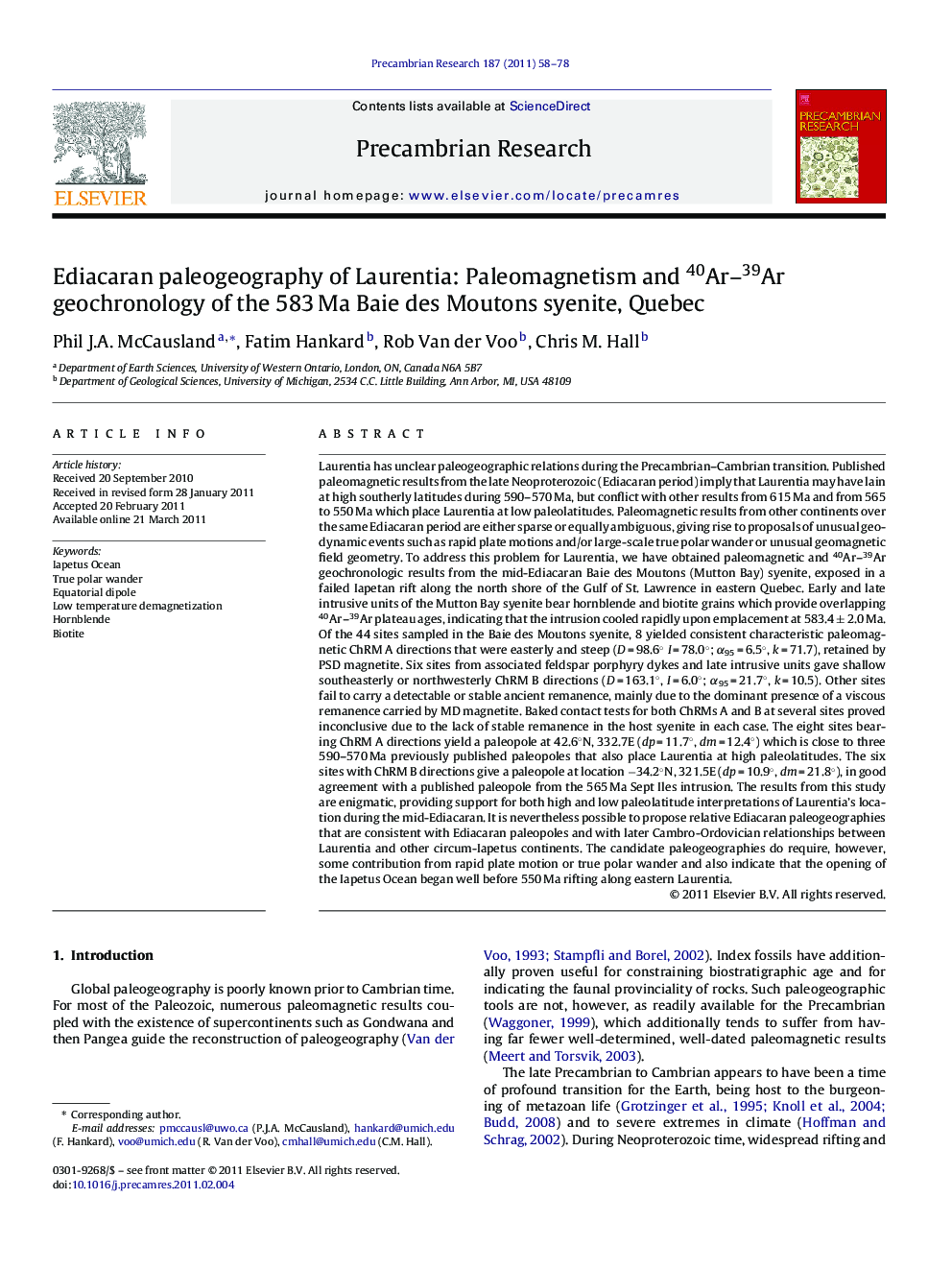| کد مقاله | کد نشریه | سال انتشار | مقاله انگلیسی | نسخه تمام متن |
|---|---|---|---|---|
| 4723838 | 1639670 | 2011 | 21 صفحه PDF | دانلود رایگان |

Laurentia has unclear paleogeographic relations during the Precambrian–Cambrian transition. Published paleomagnetic results from the late Neoproterozoic (Ediacaran period) imply that Laurentia may have lain at high southerly latitudes during 590–570 Ma, but conflict with other results from 615 Ma and from 565 to 550 Ma which place Laurentia at low paleolatitudes. Paleomagnetic results from other continents over the same Ediacaran period are either sparse or equally ambiguous, giving rise to proposals of unusual geodynamic events such as rapid plate motions and/or large-scale true polar wander or unusual geomagnetic field geometry. To address this problem for Laurentia, we have obtained paleomagnetic and 40Ar–39Ar geochronologic results from the mid-Ediacaran Baie des Moutons (Mutton Bay) syenite, exposed in a failed Iapetan rift along the north shore of the Gulf of St. Lawrence in eastern Quebec. Early and late intrusive units of the Mutton Bay syenite bear hornblende and biotite grains which provide overlapping 40Ar–39Ar plateau ages, indicating that the intrusion cooled rapidly upon emplacement at 583.4 ± 2.0 Ma. Of the 44 sites sampled in the Baie des Moutons syenite, 8 yielded consistent characteristic paleomagnetic ChRM A directions that were easterly and steep (D = 98.6° I = 78.0°; α95 = 6.5°, k = 71.7), retained by PSD magnetite. Six sites from associated feldspar porphyry dykes and late intrusive units gave shallow southeasterly or northwesterly ChRM B directions (D = 163.1°, I = 6.0°; α95 = 21.7°, k = 10.5). Other sites fail to carry a detectable or stable ancient remanence, mainly due to the dominant presence of a viscous remanence carried by MD magnetite. Baked contact tests for both ChRMs A and B at several sites proved inconclusive due to the lack of stable remanence in the host syenite in each case. The eight sites bearing ChRM A directions yield a paleopole at 42.6°N, 332.7E (dp = 11.7°, dm = 12.4°) which is close to three 590–570 Ma previously published paleopoles that also place Laurentia at high paleolatitudes. The six sites with ChRM B directions give a paleopole at location −34.2°N, 321.5E (dp = 10.9°, dm = 21.8°), in good agreement with a published paleopole from the 565 Ma Sept Iles intrusion. The results from this study are enigmatic, providing support for both high and low paleolatitude interpretations of Laurentia's location during the mid-Ediacaran. It is nevertheless possible to propose relative Ediacaran paleogeographies that are consistent with Ediacaran paleopoles and with later Cambro-Ordovician relationships between Laurentia and other circum-Iapetus continents. The candidate paleogeographies do require, however, some contribution from rapid plate motion or true polar wander and also indicate that the opening of the Iapetus Ocean began well before 550 Ma rifting along eastern Laurentia.
► This work on the Baie des Mountons syenite provides new 40Ar–39Ar ages of 583 Ma for intrusive magmatism on the rift system bordering Laurentia's eastern margin, helping to define the major Ediacaran rifting event there that led to the development of the Iapetus Ocean.
► Paleomagnetic results from the syenite give both low and high paleolatitude results, thus deepening the enigmatic global paleomagnetic record for the Ediacaran.
► Possible Ediacaran paleogeographies based on existing paleomagnetic data require either an early (∼615 Ma) opening of the Iapetus Ocean between Laurentia, Baltica and West Gondwanan cratons, or an Iapetus Ocean that was already in existence at the start of the Ediacaran.
Journal: Precambrian Research - Volume 187, Issues 1–2, May 2011, Pages 58–78